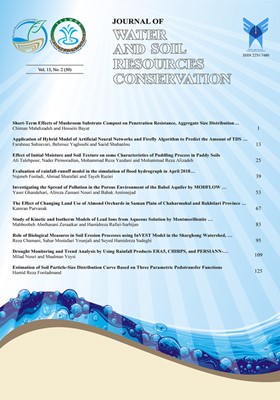Estimation of Soil Particle-Size Distribution Curve Based on Three Parametric Pedotransfer Functions
Subject Areas : New topics in soil physics
1 - Associated Professor of Irrigation and Drainage, Marvdasht Branch, Islamic Azad University, Marvdasht, Iran.
Keywords: Particle-size distribution curve, Fars province, Pedotransfer function, UNSODA,
Abstract :
Background and Aim: The particle-size distribution (PSD) curve is one of the most important soil properties, and many models have been presented for fittng to the measurd data of this curve. Also, there are some methods for estimating of this curve including its estimation using more easily available soil properties which can be called parametric pedotransfer functions. The main objective of this study was the estimation of PSD curve with some different models based on the parametric pedotransfer functions.Method: In this study, the models of Haverkamp and Parlange (1986) with two conditions, Assouline et al. (1998), and Fredlund et al. (2000) were employed for fittng to the measued data of this curve. All mentioned models contain several parameters, and the estimation of PSD curve may be accomplished by knowing the models parameters. To do this, some equations were derived for estimating the parameters of the model of Haverkamp and Parlange (1986) in two assumptions, and the model of Assouline et al. (1998). Also, the equations for estimating Fredlund et al. (2000) model were computed from Fooladmand and Mansuri (2013). All estimated equations for the model parameters have been obtained only based on soil texture data (amounts of clay, silt, sand, geometric mean and geometric standard deviation of the particle-size diameter) which are available easily and common in measuring and computing for soil samples. For this purpose, 30 soil samples were collected from different locations in Fars Province, south of Iran to calibrate the equation, and 10 soils in this area plus 30 soils of UNSODA soil data bases were used to validate the obtained results. 40 soils in validation stage have been divided into three groups containing fine, medium and course textures. The best derived equations for estimating the parameters of the model of Haverkamp and Parlange (1986) with two assumptions, and the model of Assouline et al. (1998) were obtained by using the step by step linear regression procudure. Then, the root mean square error (RMSE), geometric mean error ratio (GMER) and geometric standard deviation of the error ratio (GSDER) have been used to evaluate the obtained results in the validation stage.Results: The results indicated that the model of Fredlund et al. (2000) was appropriate for soils with fine and course textures, and the model of Assouline et al. (1998) was appropriate for soils with medium texture. Also, the results indicated that two conditions of the model of Haverkamp and Parlange (1986) were not appropriate for estimating the PSD curve.
Assouline, S., Tessier, D., & Bruand, A. (1998). A conceptual model of the soil water retention curve. Water Resources Research. 34: 223-231.
Beigi Harchegani, H., & Ostovari, Y. (2013). Evaluation and comparison of Grey GM (1,1) and Skaggs models in estimating particle size distribution of soils in the Shahrekord plain. Journal of Water and Soil. 26(6): 1318-1328. (In Persian)
Fooladmand, H. R. & Sepaskhah, A. R. (2006). Improved estimation of the soil particle-size distribution from textural data. Biosystem Engineering. 94: 133-138.
Fooladmand, H. R. & Hadipour, S. (2012). Evaluation of parametric pedotransfer functions for estimating soil water characteristic curve in Fars province. Journal of Water and Soil Science. 15(4) : 25-37. (In Persian)
Fooladmand, H. R., & Mansuri, M. (2013). Comparison of two models for estimating soil particle-size distribution curve based on soil textural data. Archives of Agronomy and Soil Science. 59: 83-92.
Fooladmand, H. R. & Golkar, P. (2018). Fitting different models of soil-moisture characteristic curve on 30 soil samples in Fars province. Journal of Water and Soil Conservation. 25(1) : 319-326. (In Persian)
Fredlund, M. D., Fredlund, D. G., & Wilson, G. W. (2000). An equation to represent grain-size distribution. Canadian Geotechnical Journal. 37: 817-827.
Haverkamp, R., & Parlange, J. Y. (1986). Predicting the water retention curve from particle-size distribution: I. Sandy soils without organic matter. Soil Science. 142: 325-339.
Leij, F. J., Alves, W. J., van Genuchten, M. Th., & Williams, J. R. (1996). The UNSODA unsaturated soil hydraulic database user’s manual. Version 1.0. Tech. Rep. EPA/600/R-96/095. U.S. EPA, Cincinnati, OH.
Mahadule, P. A., Ranshur, N. J., & Patil, M. R. (2023). Particle size distribution models fitting in silty clay and silty clay loam textures soils of Pune district. The Pharma Innovation Journal. 12(6): 99-102.
Moosavi, A. A., Mansoorinasab, H., & Mostafavi, M. (2012). Modified Skaggs model for prediction of soil particle-size distribution from limited textural data. International Journal of Agricultural Research and Review. 2(4): 373-380.
Nabizadeh, E., & Beigi Harchegani, H. (2011). Perforemance of eight mathematical models in describing particle size distribution of some soils from Charmahal-va-Bakhtiari province. Journal of Water and Soil Science. 57: 63-75. (In Persian)
Shirazi, M. A., & Boersma, L. (1984). A unifying quantitative analysis of soil texture. Soil Science Society of America Journal. 48: 142-147.
Skaggs, T. H., Arya, L. M., Shouse, P. J., & Mohanty, B.P. (2001). Estimating particle-size distribution from limited soil texture data. Soil Science Society of America Journal. 65: 1038-1044.
Tietje, O., & Hennings, V. (1996). Accuracy of the saturated hydraulic conductivity prediction by pedo-transfer functions compared to the variability within FAO textural classes. Geoderma. 69: 71-84.
van Genuchten, M. Th. (1980). A closed form equation for predicting the hydraulic conductivity of unsaturated soils. Soil Science Society of America Journal. 44: 892-898.
_||_

